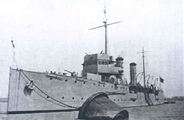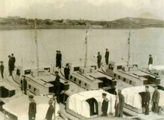- Navy:
- Republic of China Navy (Nanjing), 1940-45
- Name:
- ä¸čŹŻć°‘國海軍=Zhonghua Minguo Haijun
- Career:
Faced with the resistance of the Government of the Republic of China under General Jiang Jieshi (Chiang Kai-shek) and its refusal to negotiate a surrender, the Japanese invaders sought to undermine its authority by creating a rival government in the occupied territories. On March 30, 1940, they established the Reorganized National Government of China, with its capital in Nanjing. The new government took in the governments constituted in other Chinese territories, except the Manzhouguo Empire. The chairman of the government was the former Republic of China prime minister and political rival of Jiang Jieshi, Wang Jingwei.
Wang assumed the Navy ministry for two months and later appointed General Ren Yuandao to the post. He in turn was replaced in 1944 by Vice Admiral Ling Xiao. The new “Republic of China Navy” absorbed other Chinese naval forces created by the Japanese Navy: the North China Special Gunboat Corps, the Naval Patrol Corps and the Higher Naval Inspection Corps. The new navy only received old Chinese Navy ships sunk or captured and repaired by the Japanese, supplemented with dozens of patrol launches built in Jiangnan shipyard (Shanghai) during the war. In all three gunboats (Haixing, Haixiang, Xieli), 19 patrol boats (Haihu, Tongchun, Haisui, Haijing, Minde, Heping, Donghai, Haihe, Kaiming, Pingzhi, Jiangsu, Jianghe, Jiangya, Jiangwei, Jiangxuan, Jiangquan, Jiangyang, Jiangshao, Yudao), 50 patrol launches and 22 auxiliary ships served in the Nanjing Navy. In 1944 it had a force of 10,000 men, distributed between the central services in Nanjing (Department of the Navy, Naval Academy, Hydrographic Service) and the Naval Departments of Weihaiwei in the North, Guangzhou in the South and Nanjing, Jiangyin (only for a few months in 1941) and Hankou (from 1943) in the Yangtze valley.
Several ships were lost in operations against the guerrillas, including the gunboat Xieli and the patrol boat Jiangquan (sunk by successive mines on 17 and 19 March 1943) in Guangzhou and nine patrol boats in the Yangtze. The main units of the Department of Weihaiwei revolted at Liugong Island on 5 November 1944. After killing the Japanese instructors and taking control of the facilities, they escaped in the patrol boats Tongchun, Donghai, the patrol launch Jiang 23 and the auxiliary vessel Shengli. Next day they reached the territory controlled by Communist guerrillas, sank the ships and joined the guerrillas. In September 1945 all Nanjing forces surrendered to the government of Jiang Jieshi. Most personnel, except for some senior officers, were incorporated into the Nationalist troops, fighting against the Communist forces of Mao Zedong (Mao Tse-tung).



-hasta-3-2-1943.jpg)


